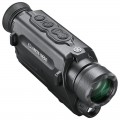Detection range
The greatest distance at which a night vision device is capable of detecting individual objects.
The methods by which manufacturers determine this parameter may vary in detail, but the general principle is the same. Usually, the distance is indicated at which, with an illumination of 0.05 lux (a quarter of the moon) and a medium-contrast background, a rather large object can be seen — for example, a human figure with a height of about 170 cm is most often taken. of this object, but only to notice the very fact of its presence. Simply put, a detection range of, say, 200 m means that “something that looks like a person” can be seen in such a device at a distance of 200 m, but individual parts (head, hands) cannot be disassembled.
It is also worth noting that in fact this parameter is highly dependent on the characteristics of the situation. For example, a dark object on a very light background will be visible further, and on a dark one it may not be noticeable even up close; a similar phenomenon is observed for thermal imagers (see "Type"), only regarding the difference in temperature, and not in colours.
Digital magnification
The maximum magnification that a night vision device can achieve through digital image processing.
This function is available only in thermal imagers and some digital models of classic night vision devices (see "How it works"). In general terms, it can be described as follows: the device electronics takes part of the image from the NVD receiver and “stretches” it to the entire frame visible to the user, due to which objects in the field of view look larger. At the same time, this procedure reduces the clarity of the visible image. Therefore, models with digital zoom are quite rare, and even in such cases it plays an auxiliary role and has a very limited magnification — usually less than 2x.
Field of view at 100 m
The size of the area visible in the night vision device from a distance of 100 m — in other words, the largest distance between two points at which they can be seen simultaneously from this distance. It is also called "linear field of view". Along with the angular field of view (see below), this parameter characterizes the space covered by the optics; at the same time, it more clearly describes the capabilities of a particular model than data on viewing angles.
Angular field of view
The angle of view provided by a night vision device — that is, the angle between the lines connecting the observer's eye with the two extreme points of visible space. Wide viewing angles allow you to cover a large area, but the magnification factor (see above) is low; in turn, increasing the magnification leads to a decrease in the field of view.
Wavelength
The wavelength of infrared radiation emitted by the IR illuminator installed in the night vision device. In most cases, this parameter is purely reference: manufacturers usually select the wavelength in such a way that it best suits the features of the device and provides the claimed characteristics. Nevertheless, a practical moment is also associated with the wavelength — the "visibility" or "invisibility" of the illuminator (see "Invisible radiation spectrum").
Continuous operating time
The longest time that the device is able to work continuously from fresh batteries without replacing / recharging them. It should be taken into account that manufacturers usually indicate this time for perfect conditions: high-quality batteries, low brightness of the visible image, operation without the use of IR illumination, video output and video recorder (if available, see "Additional"), optimal operating temperature (see below) ) etc. Therefore, in fact, the time of continuous operation may well be lower than stated. Nevertheless, this parameter makes it possible to both evaluate the battery life of individual devices and compare them with each other.
Weight
The total weight of the night vision device in the working position. If a helmet-mask is included in the kit (see above), its weight, usually, is also taken into account.
The large weight of the device makes it inconvenient to use — both when working with hands and when attached to a helmet-mask. On the other hand, with similar characteristics, lighter models will either cost more or have poor quality materials.

